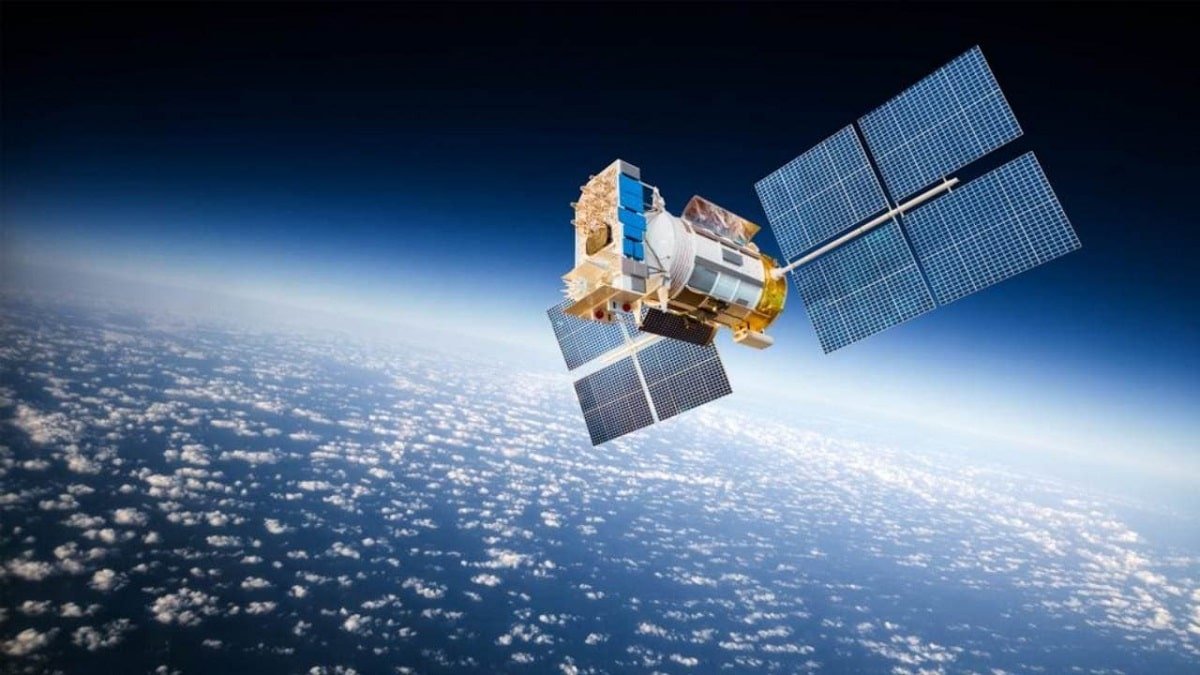Why in the News?
- AstroSat, India’s first dedicated space observatory, has completed a decade of successful operations since its launch on September 28, 2015.
- Though designed for a mission life of five years, it continues to function effectively, providing high-quality data and discoveries across astronomy.
Key Highlights
- The Launch (2015)
- AstroSat was launched on 28 September 2015 by the PSLV-C30 (XL) rocket from Satish Dhawan Space Centre, Sriharikota.
- It marked India’s entry into space-based multi-wavelength astronomy, a domain dominated by agencies like NASA and ESA.
- Mission Design and Objectives
- The observatory was designed with a planned lifespan of five years, but it has surpassed expectations and continues to operate successfully even after ten years.
- Its main objective was to observe the universe across different regions of the electromagnetic spectrum, namely visible, ultraviolet (UV), soft X-ray, and hard X-ray bands.
- Payload Development
- AstroSat carried five major scientific payloads to enable multi-wavelength observations:
- Ultra Violet Imaging Telescope (UVIT): for ultraviolet and visible imaging.
- Large Area X-ray Proportional Counter (LAXPC): for timing studies of X-ray sources.
- AstroSat carried five major scientific payloads to enable multi-wavelength observations:
- Cadmium-Zinc-Telluride Imager (CZTI): for high-energy X-ray and gamma-ray studies.
- Soft X-ray Telescope (SXT): for low-energy X-ray studies.
- Scanning Sky Monitor (SSM): for monitoring variable X-ray sources.
- Major Scientific Discoveries (2015-2025)
- It provided valuable insights into black holes and neutron stars through precise X-ray observations.
- It monitored stellar flares from Proxima Centauri, the nearest star to the Sun.
- It achieved the first detection of far-ultraviolet (FUV) photons from galaxies located 9.3 billion light-years away, a landmark discovery in observational cosmology.
- It contributed to gamma-ray burst (GRB) studies and variability patterns of high-energy cosmic sources.
- Collaborative Efforts and Global Recognition
- AstroSat was developed by ISRO in collaboration with major Indian institutions such as IUCAA, TIFR, IIA, and RRI, along with several Indian universities.
- It also had international partnerships with institutions from Canada and the United Kingdom, showcasing India’s scientific diplomacy and global cooperation in space research.
- Its long-term performance and discoveries have placed India among leading nations in space-based astrophysics.
| PSLV (Polar Satellite Launch Vehicle)
1. India’s most successful launch vehicle, nicknamed the workhorse of ISRO. 2. Can place satellites into polar, geosynchronous transfer, and low-Earth orbits. 3. Known for high reliability and low cost. 4. Launched AstroSat under the PSLV-C30 mission. 5. Strengthened India’s profile in commercial satellite launches. Electromagnetic Spectrum 1. The electromagnetic (EM) spectrum represents the full range of electromagnetic radiation, from low-frequency radio waves to high-frequency gamma rays. 2. Different regions (radio, microwave, infrared, visible, ultraviolet, X-rays, gamma rays) correspond to different wavelengths and energies. 3. Visible light is only a tiny portion of the spectrum, detectable by the human eye. 4. Observing the universe across multiple bands reveals different physical processes — e.g., radio for cold gas, infrared for dust, X-rays for compact objects. 5. Space-based observatories like AstroSat are essential because Earth’s atmosphere blocks most EM radiation except visible light and some radio waves. Black Holes 1. A black hole is a region in space where gravity is so strong that not even light can escape. 2. They form when massive stars collapse at the end of their life cycles. 3. The event horizon marks the boundary beyond which nothing can return. 4. Black holes are detected indirectly by observing X-ray emissions, gravitational waves, or their effect on nearby stars and matter. 5. They play a crucial role in galaxy evolution, high-energy astrophysics, and testing Einstein’s theory of general relativity. Neutron Stars 1. A neutron star is the collapsed core of a massive star after a supernova explosion. 2. They are incredibly dense. A teaspoon of neutron-star material weighs billions of tonnes. 3. Composed mostly of neutrons, they represent matter in one of its most extreme states. 4. Some neutron stars emit pulsed radiation and are known as pulsars. 5. Studying them helps in understanding nuclear physics, strong gravity, and the behavior of matter under extreme conditions. Stellar Flares 1. Stellar flares are sudden, intense bursts of radiation caused by magnetic activity on a star’s surface. 2. They release huge amounts of energy across the EM spectrum, from radio waves to X-rays. 3. On Earth’s Sun, these are called solar flares, but similar events occur on other stars. 4. They can affect the habitability of exoplanets, especially around small stars like Proxima Centauri. 5. Space observatories detect these flares to study stellar magnetic fields and star–planet interactions. Far Ultraviolet (FUV) Astronomy 1. Far Ultraviolet (FUV) refers to the wavelength range between 122 and 200 nanometers in the electromagnetic spectrum. 2. FUV light is absorbed by Earth’s atmosphere, so it can only be studied through space-based telescopes. 3. It is crucial for studying young stars, hot interstellar gas, and distant galaxies. 4. AstroSat achieved a breakthrough by detecting FUV photons from galaxies 9.3 billion light-years away. 5. FUV astronomy provides insights into cosmic evolution, star formation, and early galaxy development. |
Implications
- Scientific Advancements
- AstroSat enabled Indian scientists to study stellar evolution, compact objects, and galaxy formation at international standards.
- It provided simultaneous multi-wavelength data, which is crucial for understanding the physical processes in celestial bodies.
- Technological Development
- India demonstrated the ability to build sensitive space-based instruments such as UV and X-ray detectors.
- The mission strengthened India’s capabilities in satellite design, payload integration, and space-based optics.
- International Positioning
- AstroSat positioned India as a serious contributor in global astrophysics research.
- Its collaborative nature built scientific linkages with foreign institutions, enhancing India’s soft power.
- Future Mission Pathways
- The mission created a foundation for advanced observatories such as XPoSat (X-ray Polarimeter Satellite), planned for launch soon.
- It helped India gain experience in planning long-duration scientific missions.
- Educational and Research Benefits
- The mission allowed Indian universities and students to directly access observational data.
- It encouraged research-based training in astrophysics and instrumentation within India.
| XPoSat (X-ray Polarimeter Satellite)
1. XPoSat is India’s upcoming dedicated X-ray polarimetry mission, expected to study the polarization of X-rays from celestial sources. 2. X-ray polarization helps reveal details about the geometry, magnetic fields, and emission mechanisms of high-energy cosmic objects. 3. The mission carries two payloads: POLIX (Polarimeter Instrument in X-rays) and XSPECT (X-ray Spectroscopy and Timing instrument). 4. It will focus on compact objects like black holes, neutron stars, and pulsars, continuing AstroSat’s legacy. 5. XPoSat will make India only the second nation after the US to launch a dedicated X-ray polarimetry satellite, boosting India’s role in global astrophysics research. |
Challenges and Way Forward
| Challenges | Way Forward |
| The instruments were not originally designed for decadal use, though they continue to function. | Build upgradable payloads and modular designs in future observatories. |
| India still depends on foreign space telescopes (Hubble, Chandra, JWST) for higher-resolution data. | Develop next-generation high-resolution telescopes indigenously. |
| Limited public awareness of AstroSat’s contributions compared to ISRO’s rocket launches. | Strengthen science communication and citizen science programmes. |
| Space-based astronomy requires higher budgets, which compete with other ISRO priorities. | Create dedicated funding mechanisms for space science. |
| Current research is ISRO-led, with limited academic autonomy. | Move towards academia- led missions with ISRO as technical facilitator. |
Conclusion
AstroSat is a milestone in India’s space science journey, symbolising the country’s ability to conduct cutting-edge multi-wavelength astronomy. Its achievements extend far beyond its expected life, delivering discoveries of global importance. The mission provides a launchpad for India’s future astrophysics projects, ensuring that India transitions from being a participant to a leader in global space science.
| Ensure IAS Mains Question
Q. Discuss the significance of AstroSat in India’s space science programme. How does it contribute to India’s scientific standing, and what lessons does it provide for future astronomy missions? (250 words) |
| Ensure IAS Prelims Question
Q. With reference to AstroSat, consider the following statements: 1. It is India’s first dedicated multi-wavelength space observatory. 2. It was launched by PSLV-C30 in 2015 from Sriharikota. 3. It was designed for ten years but ended after five years. Which of the statements given above is/are correct? a) 1 and 2 only b) 2 and 3 only c) 1 and 3 only d) 1, 2 and 3 Answer: a) 1 and 2 only Explanation Statement 1 is correct: AstroSat is India’s first dedicated multi-wavelength space observatory, designed to observe the universe across ultraviolet, visible, soft X-ray, and hard X-ray regions of the electromagnetic spectrum. Before AstroSat, Indian astronomers primarily depended on foreign observatories like NASA’s Chandra or ESA’s XMM-Newton. Hence, this mission marked India’s entry into advanced space-based astronomy with independent capability. Statement 2 is correct: AstroSat was launched on 28 September 2015 by the PSLV-C30 (XL configuration) rocket from Satish Dhawan Space Centre, Sriharikota. The successful launch demonstrated India’s ability not only to place satellites into orbit but also to carry a complex, multi-payload observatory. This made India the fourth nation to have a dedicated space observatory after the US, Russia, and Japan. Statement 3 is incorrect: AstroSat was originally designed for a mission life of five years, not ten. Despite this, it has continued to operate successfully for over a decade, well beyond its expected lifespan. The misconception arises because its prolonged operation has made it seem like a ten-year mission. Its extended life showcases the robustness of Indian space engineering. |
|
Also Read |
|
| UPSC Foundation Course | UPSC Daily Current Affairs |
| UPSC Monthly Magazine | CSAT Foundation Course |
| Free MCQs for UPSC Prelims | UPSC Test Series |
| ENSURE IAS NOTES | Our Booklist |





